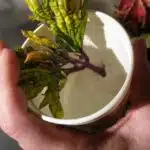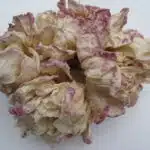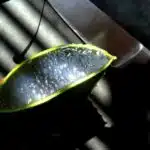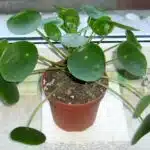Roses have a long and storied history, having been grown and admired since the days of ancient Greece. Over the centuries, they have come to symbolize love, beauty, and even perfection. But what if you could share a piece of their beauty with others? Propagating roses from stem cuttings is one way to do just that – it’s an easy process that anyone can learn with a little practice and patience.
Imagine being able to take one rose cutting, nurture it into maturity, and then share its beauty with friends or family. It’s not only a wonderful feeling but also a great way to serve others by providing them with something special that you grew yourself. With just some basic tools and supplies, you can propagate beautiful roses from stem cuttings in no time!
Propagating roses from stem cuttings is relatively straightforward. All you need are some healthy stems from existing plants, rooting hormone or compost tea, potting soil mix or perlite-vermiculite mix, pots or trays for planting your cuttings in, and water. Once you have gathered your supplies together, it’s simply a matter of following some basic steps in order to ensure success. So let’s get started!
Gather Supplies For Propagating Roses From Stem Cuttings
Propagating roses from stem cuttings is a rewarding and fulfilling process. It requires careful planning, the right tools and materials, and an eye for detail. But if you get it right, the results can be truly amazing! So what supplies do you need to successfully propagate a rose cutting?
In this article, we’ll provide you with a comprehensive list of everything required to get started. We’ll also go through some helpful tips that will make the process easier and ensure your success. Let’s dive in!
Before you start propagating your roses, gather all the necessary supplies. This includes things like sharp pruning shears or scissors; rooting hormone; clean pots or containers with drainage holes; potting mix for cuttings; and clear plastic bags to cover the stems after cutting them. Once you have gathered all these materials, it’s time to prepare the cutting itself. Choose healthy stems that are at least six inches long and have several leaves on them. Cut just below a node (the area where leaves attach) using sterilized shears or scissors. Dip the base of each stem into rooting hormone powder or liquid before planting in moistened potting mix. Place into a warm location with indirect sunlight and water regularly until roots appear – usually within four weeks – before transplanting into your garden beds or larger containers when ready.
With a little bit of patience and care, propagating roses from stem cuttings can be an enjoyable project for any gardener!
Choose Healthy Stems For Cutting
Ah, the age-old question: how does one propagate roses from stem cuttings? Well, you’ve come to the right place. All you need for success is a few supplies and some basic knowledge of healthy stems to cut. Here’s what you do:
- Equip yourself with a pair of gardening shears, a potting medium and a container with drainage holes.
- When selecting healthy stems, look for ones that are firm and green. You want to avoid any that are wilted or discolored.
- Choose stems that are around 6 inches in length, preferably with buds on them so they can root quickly.
Now that you have your supplies and the perfect cuttings selected, it’s time to get ready for planting! But before you jump into the joys of propagation, there’s still one important step left: preparing the cuttings for planting.
Prepare The Cuttings For Planting
Now that you’ve chosen healthy stems for your rose cuttings, it’s time to prepare them for planting. This is an important step in the propagation process, so let’s go through it together.
First, you’ll need to remove any leaves and thorns on the lower section of your cutting. Removing these will help minimize the risk of disease and rot. Once that’s done, you can snip off the bottom of each stem at a 45-degree angle with sharp pruners or scissors. This gives the stem more surface area to absorb water and promotes quick rooting.
Finally, dip the end of each cutting into a root hormone powder or liquid to stimulate root growth before planting it in its final destination. This step is optional but highly recommended; it helps ensure successful propagation and minimizes stress on the new plant.
Now that you know how to prepare your cuttings for planting, it’s time to select a suitable growing medium for your roses.
Select A Suitable Growing Medium
Choosing the ideal growing medium is a critical step in propagating roses from stem cuttings. It’s so essential, in fact, that it could be the difference between success and failure! To make sure you get it right, here are four key things to consider when selecting a suitable growing medium:
Firstly, you’ll want something that provides good drainage and air circulation. Secondly, it should be lightweight enough to support delicate new roots without weighing them down. Thirdly, it should be able to hold moisture but not become waterlogged. And lastly, it should contain some nutrients for your rose cuttings to feed off of as they take root.
It can be tempting to try out different types of soil or use whatever you have lying around – but don’t do it! If your chosen growing medium fails to meet any of the criteria listed above, your rose cuttings won’t stand a chance at survival. Instead, stick with tried-and-true options like potting mix or specialized rooting mediums made especially for cuttings. You’ll thank yourself later when you see your roses thriving!
Once you’ve picked the perfect growing medium, you’re ready to move onto the next step: planting your cuttings and watching them bloom into beautiful roses!
Plant The Cuttings
Now that the growing medium has been chosen, it’s time to move on to planting the stem cuttings. To begin, take a cutting and trim off any leaves that are lower than the soil level. This will help prevent rotting before the plant takes root. Once trimmed, make a hole in the soil that is slightly deeper and wider than the cutting itself. With a firm but gentle hand, place your cutting into the hole and fill around it with soil until it is stable and secure. If done correctly, you should be able to see just a couple of leaves above ground level.
After planting your cuttings, it’s important to water them properly. It is best to water from below or mist lightly with a spray bottle so as not to disturb the soil around them. Be sure not to over-water your stems as this can also cause rot or encourage fungal growth in the soil. Just enough water for the soil to be lightly damp is all that is necessary for now.
The next step in propagating roses from stem cuttings is monitoring their progress. Check on them regularly by looking for signs of new leaf growth or rooting within two weeks of planting them. If none of these signs appear after four weeks, you may need to try again with another cutting from a different source if possible. With patience and care, you’ll soon have beautiful rose bushes growing in no time!
Water And Monitor The Cuttings
It’s time to jump in with both feet! After carefully planting the rose stem cuttings, it’s now time to water and monitor them. Just like a new plant needs care and attention to get off the ground, so do these cuttings. Here are a few tips to keep in mind:
First off, make sure you give your roses plenty of water. They need at least an inch of water a week. To get this necessary amount of hydration, use a garden hose or watering can and make sure to evenly distribute the water across all the cuttings.
Second, keep an eye on your roses as they grow and develop. If you notice any signs of drooping leaves or wilting stems, it’s likely that they need more water or possibly even fertilizer. Don’t wait until it’s too late – act fast if you notice anything out of the ordinary!
Finally, provide adequate sunlight for the cuttings to thrive. This means finding a spot in your garden or yard that gets at least six hours of direct sunlight each day. Once you’ve found a suitable location for your roses, be sure to check back regularly and make sure that they are getting enough light throughout the day. With proper care and attention, you’ll have beautiful roses popping up in no time!
Provide Adequate Sunlight
It is estimated that up to 80 percent of plants, including roses, need adequate sunlight to thrive. Providing adequate sunlight when propagating roses from stem cuttings is an essential step to ensure successful plant growth.
When caring for a cutting, it’s important to consider the amount of sunlight it receives each day. Place the cutting in a place with full sun exposure between six and eight hours per day. If you’re unable to provide this much direct sunlight, then supplement with artificial lighting. This will help promote healthy root growth and allow the cutting to establish itself before being moved outdoors.
If you live in an area with intense heat or strong winds, it might be necessary to provide some shade during certain times of day or cover the cuttings with burlap or other breathable material while they are establishing roots. Once they’ve established themselves, they can be gradually acclimated to direct sun exposure if needed. With the right care and attention, these cuttings will eventually grow into beautiful roses that you can enjoy for years to come!
Next up we’ll discuss how applying fertilizer can help give your rose cuttings a boost as they begin their journey towards blooming!
Apply Fertilizer
Did you know that roses are one of the most popular plants in the world? A 2020 survey found that 90 percent of gardeners have grown roses at least once in their lifetime. So, it’s no surprise why so many people want to propagate their own rose cuttings. The eighth step is applying fertilizer.
When fertilizing your cuttings, it’s important to choose a slow-release fertilizer for best results. This type of fertilizer will give your roses a steady supply of nutrients over time and help them establish strong roots sooner. Make sure to mix the fertilizer with the soil before planting and spread it evenly around the cuttings. Fertilizer can also be applied as a top dressing around the rose bushes later during their growth cycle.
It’s also important not to over-fertilize your roses as this can damage them. When applying fertilizer, always follow the instructions on the package, and apply only when necessary. If you provide too much fertilizer, it could burn or stunt the growth of your roses and cause other issues such as nutrient deficiencies or yellowing leaves.
Next up, we’ll discuss how to pinch back the tips of the cuttings for optimal growth and development.
Pinch Back The Tips Of The Cuttings
To complete the process of propagating roses from stem cuttings, it’s time to pinch back the tips of the cuttings. It might seem counterintuitive to pinch off the growth at this stage, but it’s essential for success. Just like a gardener pruning a bush, pinching back encourages new growth and keeps everything healthy.
To illustrate, consider an example from my own garden. Last summer, I was propagating some cuttings of my favorite climbing roses. After several weeks in water, they were ready to pot up and move into the garden. The last step before transplanting them was to give each cutting a nice trim with clean scissors. By removing just the tips of each shoot I was able to promote dense and healthy foliage down the line.
The benefits of pinching back are threefold:
- Pruning encourages branching which can lead to more blooms;
- Cutting off dead or damaged shoots prevents disease from spreading;
- And tidying up helps keep plants looking neat and tidy.
Pruning is an important part of any gardening routine and it’s no different here with rose cuttings. Although it can be hard for us to take away something that we’ve worked so hard on, in the long run it will be worth it when we’re rewarded with beautiful flowers come springtime! Now that we’ve taken care of this step, all that’s left is to transplant our cuttings into their new home.
Transplant The Cuttings
Transplanting the rose cuttings may seem like a daunting task, but it is actually quite simple. The process can be likened to planting a seed: with a little bit of effort and care, you can grow something beautiful. Here are some steps you can follow to ensure success in transplanting your rose cuttings:
• Preparing the Soil: Preparing the soil for your cuttings should be done before you start any of the other steps. First, make sure the soil is moist but not soggy. Also ensure that it contains plenty of organic matter and nutrients so your cuttings will have the right conditions to establish themselves before they reach their permanent home.
• Transplanting: Once your soil is ready, it’s time to transplant your rose cuttings. Gently place each cutting in its new spot and firm up around it with your fingers or a trowel if needed. Make sure that each cutting has enough room to spread out its roots and get established in its new home.
• Watering: After transplanting, give each cutting a good drink of water. This will help them settle into their new environment and get off to a good start. Water them deeply every day for the first week or two and then gradually reduce watering as they become established in their new home.
Transplanting rose cuttings is an important step in propagating roses from stem cuttings – when done correctly, you’ll soon have beautiful blooms! Now that you’ve transplanted the rose cuttings, all that’s left is to monitor for pests and watch them flourish!
Monitor For Pests
At last, the moment of truth has arrived! After weeks of carefully tending to the rose cuttings, it’s time to monitor them for pests. But be warned: these nasty critters can strike at any time and wreak havoc on your beloved roses. So buckle up and get ready for an intense battle against nature’s pesky foes!
First, conduct a thorough inspection of the soil and leaves around each cutting. If you spot any signs of damage or discoloration, it might be due to a pest infestation. Check for common culprits like aphids, spider mites, thrips, and mealy bugs – all of which can cause considerable damage to your roses if left unchecked.
Next, take preventative measures to protect your plants from further harm. For instance, you can use natural predators like ladybugs or lacewings to control insect populations in your garden. You could also introduce organic pesticides such as neem oil or insecticidal soap sprays to ward off future infestations.
TIP: Be sure to monitor your rose cuttings regularly throughout their growth cycle so you can identify and treat any pest problems quickly!
Identify And Treat Diseases
Before delving into the specifics of treating diseases, it’s important to understand why this step is so crucial. After all, a healthy rose bush is much more likely to produce beautiful flowers than a sick one. Diseases can weaken the plant and prevent it from growing properly, making this step an important part of successful propagation.
Identifying and treating diseases in rose plants requires keeping a close eye on your cuttings. Regularly check for any spotting on leaves or stunted growth. In addition, pay attention to the roots: if they appear discolored or unhealthy, they may have contracted some kind of disease. If you suspect that your roses are infected, it’s best to take them out of their pots and inspect them carefully before attempting any treatment options.
The treatments for rose diseases vary depending on what kind of infection your plants have. Fungal infections can be treated with fungicides, while bacterial infections often require antibiotics or other systemic treatments. Whichever method you choose, make sure you follow the instructions closely and apply the treatment as soon as possible after diagnosing the disease – this will help ensure that your roses get back to their full health as quickly as possible!
With regular monitoring and timely intervention, rose cuttings will have every chance at thriving in their new environment. Pruning helps promote strong growth and prevent overcrowding while encouraging healthy blooms – two essential elements for a beautiful garden!
Prune The Plants
Like a sculptor working on their masterpiece, pruning is an art form when it comes to roses. Snipping off errant branches and stems helps keep the bush healthy while encouraging the plant to direct its energy into blooming vibrant flowers. With a few simple steps, you can learn how to prune your roses with the utmost care and attention.
First, use sharp, clean shears or scissors to trim back any dead or damaged parts of the plant. Then, look for any branches that are growing too long and remove them as close to the base of the stem as possible. Afterward, prune away any twiggy growth at the center of the bush and thin out any overcrowded areas. Finally, keep an eye out for shoots that cross over each other and cut them away to ensure proper airflow throughout the entire plant.
Remember that rose bushes need some room around them in order to thrive; if you’re not sure how much space they need, refer back to your original instructions or make sure there is at least a foot between each one. Pruning may seem like a daunting task but with a little practice and patience you’ll be able to master this craft in no time! With proper pruning practices in place, you’ll be well on your way towards providing winter protection for your roses.
Provide Winter Protection
As the winter season approaches, you may be concerned about how to protect your newly propagated roses from stem cuttings. With a little extra care and attention, you can ensure that your plants make it through the cold months and thrive in the spring.
Imagine a blanket of snow slowly covering your garden beds, shielding the tender rose stems from freezing temperatures. Providing winter protection for these new additions to your garden is an important step in growing healthy roses. This can include mulching around the plants with straw or hay, or wrapping them in burlap or frost cloth on particularly cold nights.
By taking these precautions, you can give your new roses every opportunity to survive until warmer weather arrives. And when it does arrive, you’ll be ready to reap the rewards of growing beautiful blooms from stem cuttings!
Reap The Rewards Of Growing Roses From Stem Cuttings
Reaching the end of this journey is like feeling the warmth of a summer sun. Growing roses from stem cuttings is a highly rewarding experience, and the end result will be beautiful blooms that will leave you in awe.
The final step to reaping the rewards of growing roses from cuttings is to provide winter protection. This means covering the plants with straw or evergreen boughs or with horticultural fleece and making sure that they are well-insulated if temperatures drop below freezing. This will ensure that your plants survive through the winter and come back healthier than ever in spring.
Now that you’ve taken all these steps, your rose garden will be ready to thrive! With careful attention and dedication, you’ll be able to enjoy lush, colorful flowers that were cultivated from stem cuttings – a unique gardening accomplishment that is sure to bring pride and satisfaction.
Frequently Asked Questions
How Often Should I Water The Cuttings?
“A stitch in time saves nine,” is an adage that applies to many aspects of life, and it is especially applicable when propagating roses from stem cuttings. Doing so requires a diligent and patient hand, with timely watering of the cuttings being one of the most important tasks. So, how often should one water the cuttings?
In general, it is best to keep the soil moist but not soggy. For this reason, water your cuttings every few days or once a week depending on the season and weather conditions. In hotter climates during summer months, consider watering twice a week as roses typically need more frequent watering during these periods. You can also tell if your cutting needs water by feeling its soil – if it’s dry then it’s time for a drink!
Additionally, be sure to monitor the humidity in your propagating environment as too much or too little humidity can lead to drying out of the cutting or failure to root. Try misting with water spray or placing a plastic dome over your potting tray as effective methods for maintaining proper humidity levels. With regular monitoring and maintenance you can easily nurture healthy rose cuttings that will soon bloom into beautiful flowers!
How Long Does It Take For The Cuttings To Root?
Roses have been a symbol of love, beauty, and admiration for centuries. Growing them from cuttings is an excellent way to increase your rose garden with little effort. However, when you are propagating roses from stem cuttings it’s important to know how long the process takes.
Curious minds want to know: how long does it take for the rose cuttings to root? Surprisingly, it doesn’t take as long as one might think. With the right environment and technique, the process can be relatively quick and easy.
To start off, it’s important to create a hospitable space for the cuttings by providing well-draining soil and plenty of water. Once they have been planted in their new homes, they need a few weeks of being kept moist before the roots begin to form and grow. After that period of time has passed, you should see signs of rooting within six weeks or less!
Ultimately there are several factors that influence how quickly rose cuttings root such as soil type and temperature. By taking these into consideration and giving your roses a bit of extra TLC you will be rewarded for your efforts with beautiful blooms in no time!
Is It Better To Use Rooting Hormone Or Not?
When it comes to propagating roses from stem cuttings, one of the most important choices is whether or not to use rooting hormone. On one hand, using rooting hormone may provide an easier and faster way for the cuttings to take root; on the other hand, it’s not always necessary.
To help you decide which approach is best for your project, let’s look at the pros and cons of using rooting hormone: • Faster rooting process: Rooting hormone speeds up the process of taking root by encouraging root growth. • Healthier plants: Roots that form with the help of rooting hormone are typically healthier than those that don’t receive any additional assistance. • Easier propagation: Using a rooting hormone may make propagating roses much easier since it reduces some of the guesswork involved in ensuring successful results. • Expense: Rooting hormones can be expensive, particularly if you’re working on a large-scale project. • Unnatural: While some people may argue that using a rooting hormone isn’t natural, there are actually many natural options available.
Ultimately, it’s up to you to decide whether or not you want to use a rooting hormone when propagating roses from stem cuttings. Just keep in mind that while using one might speed up the process and give you healthier plants in less time, it could also mean added expense and less control over the outcome. Consider all your options carefully before making a decision!
What Type Of Fertilizer Should I Use?
When it comes to propagating roses from cuttings, there are a few things to consider. One of the most important is what type of fertilizer you should use. This is an important factor in successfully growing roses from stem cuttings.
Fertilizer can help support rose growth while they’re establishing root systems and adjusting to their new environment. A slow-release fertilizer is ideal for this purpose, as it will provide balanced nutrients over time and reduce the chances of burning the roots or over-fertilizing your plants. It’s also worth noting that organic fertilizers may be better for your roses since they contain no harsh chemicals that could damage delicate root systems.
When applying fertilizer, make sure not to overdo it – start small and gradually increase if necessary. For best results, it’s recommended to work fertilizer into the soil at least once every two weeks throughout the growing season. This will give your roses all the nutrients they need to thrive and flourish in their new home!
When Should I Pinch Back The Tips Of The Cuttings?
When it comes to propagating roses from stem cuttings, pinching back the tips is an important step. But when should this be done? To ensure successful propagation, the timing of this task is critical.
Before taking the cuttings, you’ll want to pinch back their tips. This will help encourage branching and boost root growth. The timing of this task depends on several factors, such as the type of rose and your climate. Generally speaking, if you’re in a warm climate, pinch back the tips of your cuttings in late summer or early fall. For cooler climates, wait until springtime before pinching them back.
Pinching back the tips of your cuttings helps create strong roots that will eventually produce healthy plants. Taking care to do this at the right time can make all the difference in successful propagation!
Conclusion
The process of propagating roses from stem cuttings can be a rewarding experience, as you watch your new little rose bushes blossom into beautiful plants. However, it is important to remember that there are some specific steps to follow in order to ensure success. Watering the cuttings often and using rooting hormone or not can make all the difference when it comes to root development. The use of fertilizer and pinching back the tips of the cuttings will also help ensure that your new rose bush gets off to a healthy start.
So, if you’re looking for a fun project that will bring about beautiful results, propagating roses from stem cuttings is definitely worth considering. But before you get started, make sure that you’re prepared with all the necessary information regarding watering frequency, rooting hormone use, fertilizer type and timing for pinching back the tips of the cuttings.
With this knowledge in hand and a bit of patience, you’ll soon be enjoying your very own homemade rose garden!





























